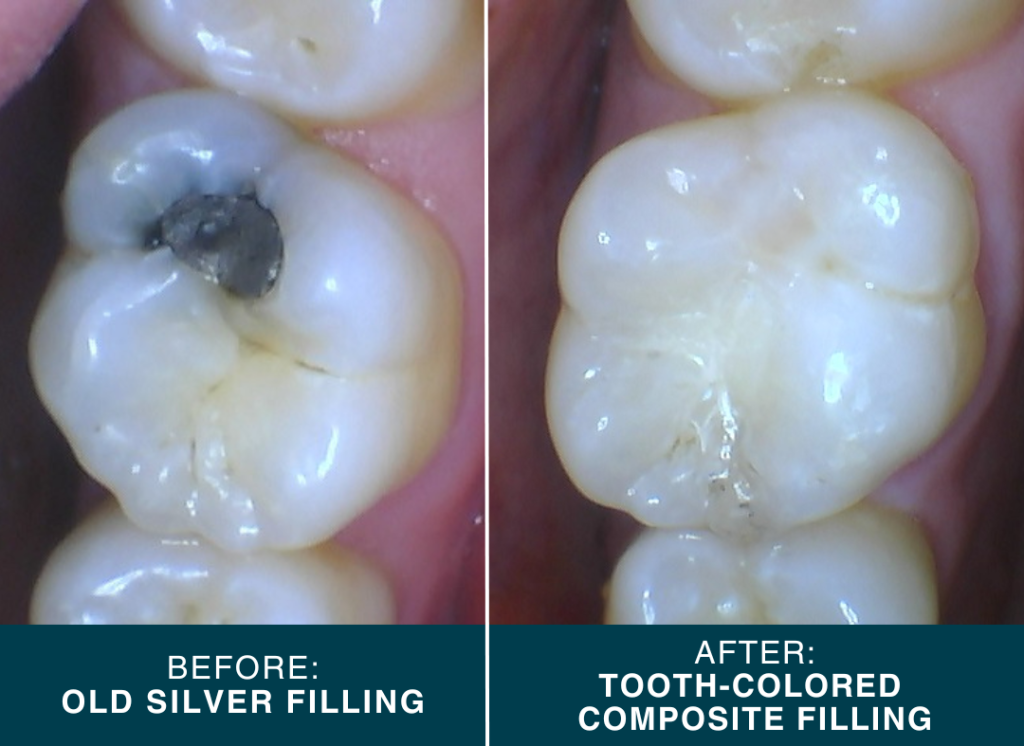A dental filling is used to restore and protect a tooth that has a cavity from tooth decay. Signs of needing a dental filling may include tooth sensitivity, discoloration, pitting, or holes in the tooth. Left untreated, a cavity can lead to much discomfort. It may even become infected, causing a toothache and requiring a root canal. A dental filling offers early intervention to preserve your natural tooth and keep your mouth healthy. If you believe you may need a dental filling in the Washington, DC area, call our team to schedule your appointment today!
What Is A Dental Filling?
A dental filling is a procedure that’s used to fill a hole in your tooth, also known as a cavity. Cavities are caused by tooth decay. As oral bacteria consume sugar and excrete acid, this weakens the tooth, causing it to decay. Over time, prolonged decay will destroy the outer layer of the tooth, resulting in a cavity. A filling is used to treat this issue. The damaged enamel is removed by the dentist. Then, durable, tooth-like material is used to fill the cavity. The filling is shaped so that it fits in with the rest of your tooth. Then, it’s hardened and your bite is tested to ensure that your tooth is completely restored, and can function as it should.
Early intervention with a dental filling is the best way to restore and repair a decayed tooth. Without a filling, the cavity will only get worse, and this could result in more pain, costly dental treatments, and the need to spend extensive time at the dentist’s office.
What Type of Fillings Do You Office?
We exclusively treat patients with dental composite fillings. They come in a variety of shades and colors to match the natural color of your tooth. Composite fillings are strong and durable, blending in naturally with your smile. They are also free of any metals including mercury, which some patients prefer. They’re not just more aesthetically pleasing—they’re also better for your long-term dental health:
- Virtually invisible: Blends beautifully with your natural tooth color.
- Preserves more of your tooth: The material bonds directly to your enamel.
- Stable and strong: No expansion or contraction with temperature changes, reducing the risk of cracks.
- Mercury-free and biocompatible: A safer choice for many patients.

Does It Hurt To Get A Filling?
Not at all! Getting a filling is a quick and virtually painless experience. At Washington Metro Dental, your comfort is our top priority. Before we begin, we numb the area completely with a local anesthetic so you don’t feel any discomfort during the procedure. Most patients say they feel only a little pressure or vibration—no pain. We also offer nitrous oxide (laughing gas). You can feel relaxed throughout your appointment. And, best of all, you can get back to your busy schedule with no downtime. Nitrous oxide sedation is minimal and wears off after only about five minutes.
How Long Does A Filling Last?
Typically, composite fillings have a lifespan of between 7-10 years. Over time, the filling material may start to wear out and peel away from the tooth. The best way to keep your fillings in good shape is to maintain a good at-home oral hygiene routine. Brush twice a day, floss once a day, eat a healthy, low-sugar diet, and maintain a healthy lifestyle. You also should see your dentist every six months. They will be able to check on your oral health and ensure your fillings are in good shape and recommend filling replacement when necessary.
Replacing Old Fillings
If you have older silver fillings that are worn, cracked, or simply visible when you smile, we can safely replace them with tooth-colored composites that restore both strength and beauty to your smile. Replacing old fillings is a straightforward procedure. We carefully remove the worn silver material, clean the area, and restore the tooth with composite resin that blends beautifully with your smile. Most patients are surprised by how quick and comfortable the process is—and how much better their smile looks afterward.

Composite (White) Filling Post-Op Instructions:
Click to Download Post-Op Instructions Document
- When an anesthetic has been used, your lips, teeth, and tongue may be numb for several hours after the appointment. Avoid chewing until numbness has completely worn off. It is easy to bite or burn your tongue or lip while numb.
- Your new fillings are fully hardened before you even leave the office; again though, it is wise to chew on the opposite side from the location of the newly placed filling(s) until the anesthetic has worn off.
- You may take any over-the-counter pain reliever for tenderness or discomfort. You may take Acetaminophen or Ibuprofen (Tylenol or Advil), unless you are allergic to these medications or have a medical condition that would prevent you from taking these medications. This will help with any soreness at the injection sites where your anesthetic was administered.
- It is normal to experience some hot, cold, and pressure sensitivity after your appointment. Hot or cold sensitivity may linger for several weeks after the placement of the fillings. Usually, these symptoms will subside over time.
- One of the most common problems following filling placement with anesthesia is an incorrect bite. If your bite feels uneven, please call our office so we can get you scheduled to correct your bite. Sometimes, when patients try to get used to a bite that does not feel right, it can start feeling worse rather than better. Luckily, this is usually a very simple fix. Just call our office!
Protecting Your Smile
Dental fillings can protect your teeth and help preserve them for years to come. If you are in need of a filling, call our office today to schedule your dental visit. Our team can examine your smile and provide you with the dental care that you need.

